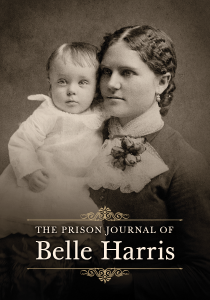Today the Church of Jesus Christ of Latter-day Saints’ Church History Department published the prison journals of Belle Harris. Harris was one of roughly a dozen women arrested during “The Raid,” the federal persecution and prosecution of Latter-day Saint polygamists from 1882-1890. Federal marshals arrested polygamists and suspected polygamists under the authority of the Edmunds Act (1882) and the Edmunds-Tucker Act (1887), which severely curtailed Latter-day Saint religious freedom and civil rights. Harris also appears in several other digitized resources produced by the Church of Jesus Christ of Latter-day Saints.

Belle Harris was imprisoned from May to August 1883 following her refusal to answer a grand jury’s questions about her relationship with Clarence Merrill (her ex-husband). Ken Adkins, a researcher at the Church History Library and the person most responsible for bringing the journal to light, noted how she was a woman impaneled before a group of male, non-Mormon jurors, with gender dynamics amplifying the difficulty of her situation. Harris’s refusal to answer questions led to her incarceration at the Utah territorial penitentiary in Sugar House, Utah (Salt Lake County). Unusually, and horrifyingly, the state imprisoned her and her ten-month-old son, Horace.
Several prominent Latter-day Saint women leaders visited Harris. Eliza R. Snow, Emmeline B. Wells, Zina Huntington Kimball Smith Young, and others buoyed her spirits and did what they could to help her. She also worked with her lawyer, A. Milton Musser, and others to share her story with the press. Her plight soon became a regional and national news story.
Like other prisoners, Harris was anxious amidst the uncertainties of incarceration. In her July 29, 1883, entry, she recorded, “I could not help feeling very lonely and longed to be among my friends . . . I have much to be greatfull for but there are times when I cannot help being depressed in spirit . . . it is trying for me to listen to the abuse heaped upon the Latter day Saints and especially the Presidency of our church.” Horace’s poor health was a complicating factor. I (the author) can’t imagine anyone maintaining their health in these circumstances. For that reason, I’m particularly struck by the idea that she was as concerned with the LDS First Presidency (John Taylor, George Q. Cannon, and Joseph F. Smith) as she was with her own situation.
Harris also had access to materials many prisoners did not. According to her July 3, 1883 diary entry, she had canned tomatoes, berries, candy, nuts, and other foods that would have been considered luxuries at the time available to her in her cell. She was also given access to a sewing machine and had free range to walk throughout the garden. Ken Adkins shared that she also had access to medical care.
Matthew McBride, Director of Publication for the Church History Department, noted that the publication of Belle Harris’s journals affirms the Department’s continued efforts to amplify the voices and experiences of women, everyday Latter-day Saints, and other communities, including in the Discourses of Eliza R. Snow and the Diaries of Emmeline B. Wells.
Q&A:
There were no notes from the judge about whether he thought it was a “favor” to allow Belle to bring Horace to the Sugar House Prison.
Her family, who know about this episode, often celebrate her faith.
Determinations for including documents on the Church Historian’s Press website are still evolving. However, significant documents, representative of Church members and leaders, well-written, and with compelling stories are considered closely. The CHD felt lucky to have “the right person at the right time” to shepherd this project (Adkins).
Comments
Be the first to comment.